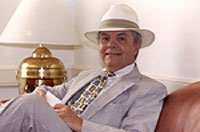skip to main |
skip to sidebar
For the past month, we have watched the slow move of a large house from Aurora Street to a hilly location on the north end of the WRA campus. For many years this house, built in the early 1960s, stood at 301 Aurora Street with its back to our property. When the new owner proposed that the house be demolished in order to make way for a larger one, WRA was contacted about accepting the residence as a gift. The house has now been successfully moved to its new position on our campus, and by next summer, should be ready for a faculty family.
hilly location on the north end of the WRA campus. For many years this house, built in the early 1960s, stood at 301 Aurora Street with its back to our property. When the new owner proposed that the house be demolished in order to make way for a larger one, WRA was contacted about accepting the residence as a gift. The house has now been successfully moved to its new position on our campus, and by next summer, should be ready for a faculty family.
It was not all that long ago that another house, the "Brick Academy," home to a girls' seminary in the mid-19th century, was moved from lower Aurora Street where it had stood next to the 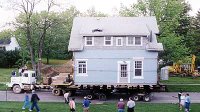 present Congregational Church since 1847. On Saturday, May 13, 2000, the structure began to make its way a quarter mile to a new location just behind the Knight Fine Arts Center on Oviatt Street. The move took all day. Once settled on a vacant Reserve lot, the structure underwent extensive restoration and received a kitchen and den addition to the rear of the house. It is now in use as a faculty residence.
present Congregational Church since 1847. On Saturday, May 13, 2000, the structure began to make its way a quarter mile to a new location just behind the Knight Fine Arts Center on Oviatt Street. The move took all day. Once settled on a vacant Reserve lot, the structure underwent extensive restoration and received a kitchen and den addition to the rear of the house. It is now in use as a faculty residence.
In the past, other houses have been moved from our campus and at least two others were added. One house, known as the Kippen house (from the owner's family name) was purchased by WRA benefactor James W. Ellsworth in 1921 and moved from the corner of Chapel Street and College to its present location at 156 Aurora Street. Another home that stood near the corner of Prospect and College Street was either moved or demolished in the early 1930s in order to provide a place for the building of Hobart House.
Two faculty homes on Hudson Street were purchased as kits from the Sears catalog, were shipped to Hudson by rail, stored behind the old Bicknell Gym, then brought over to Hudson Street and assembled on site. These include the house sometimes called the Hickok house which was marketed by Sears as "The Milford" (catalog #3385) and listed for $1359 to $1671. WRA bought the Cape Cod-style house shown in the 1934 catalog and erected it during the summer of 1935. 
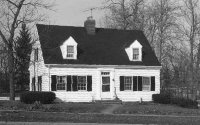 The second Sears catalog house is right next door and was marketed as "The Newcastle" (catalog #3402) , a large two-story house whose design was based on that of the 1730 Richards House in Litchfield, Ct. This model sold for $1576 to $1813 and probably was assembled in 1936. Both houses are so substantial in their framework and detailing that few would guess they had arrived on campus in a box, or rather a boxcar. Most of these Sears houses had 30,000 or more pieces and came with 750 lbs. of nails. Sears suggested they could be assembled in 90 days. So in the middle of the Depression years, WRA was able to build two fine houses for faculty use in a very economical way.
The second Sears catalog house is right next door and was marketed as "The Newcastle" (catalog #3402) , a large two-story house whose design was based on that of the 1730 Richards House in Litchfield, Ct. This model sold for $1576 to $1813 and probably was assembled in 1936. Both houses are so substantial in their framework and detailing that few would guess they had arrived on campus in a box, or rather a boxcar. Most of these Sears houses had 30,000 or more pieces and came with 750 lbs. of nails. Sears suggested they could be assembled in 90 days. So in the middle of the Depression years, WRA was able to build two fine houses for faculty use in a very economical way.
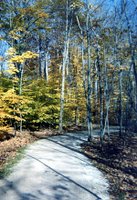 On a tip from Don Husat '64 about the ruins of an old dam in Hudson's Bicentennial Woods, we went on a field trip in early November with Lynna Piekutowski (who wrote Remembering the Boys) and discovered more than we had expected. After fording a couple of small brooks and climbing up an embankment, we looked carefully at the remains of the old stone dam probably built when this area was part of WRA benefactor James W. Ellsworth's East Woods.
On a tip from Don Husat '64 about the ruins of an old dam in Hudson's Bicentennial Woods, we went on a field trip in early November with Lynna Piekutowski (who wrote Remembering the Boys) and discovered more than we had expected. After fording a couple of small brooks and climbing up an embankment, we looked carefully at the remains of the old stone dam probably built when this area was part of WRA benefactor James W. Ellsworth's East Woods.
Then on a small rise a few hundred feet from the dam, we spied a group of bricks scattered about in the fallen leaves and went for a look. The more we dug into the old foundation, the more convinced we were that we had found the location of the Senior Cabin that had been built as a project by the Class of 1928. This class had the idea but needed to raise funds in order to build their hideaway in the woods. 

 For about a year, they raised money by showing movies on the weekend and held other fund raisers that netted them the $645 to cover expenses for construction (this at a time when WRA tuition was $800 per year). In the fall of 1927, they began construction under the watchful eye of faculty member Ralph B. Simon. They were allowed to dismantle an old chicken coop at Evamere Farm and take the timbers, which became the framework for their cabin, out to the woods. We believe the location near the dam made sense, as there would have been a small pond there at the time, and nothing but woods and fields between the cabin and Evamere Farm near the intersection of Aurora and Hudson Streets.
For about a year, they raised money by showing movies on the weekend and held other fund raisers that netted them the $645 to cover expenses for construction (this at a time when WRA tuition was $800 per year). In the fall of 1927, they began construction under the watchful eye of faculty member Ralph B. Simon. They were allowed to dismantle an old chicken coop at Evamere Farm and take the timbers, which became the framework for their cabin, out to the woods. We believe the location near the dam made sense, as there would have been a small pond there at the time, and nothing but woods and fields between the cabin and Evamere Farm near the intersection of Aurora and Hudson Streets.
We knew there were photos (below) in WRA Archives documenting this project, which was completed in the spring of 1928 when the class hosted Headmaster Ralph Boothby at a picnic at the site. The class planned to use it for reunion picnics, but deeded it over to the Class of 1929 and their successors. Our records show that it was used intermittently (no overnight stays without faculty supervision) through 1937.
By 1940, the cabin had fallen into disrepair and
an effort was launched to repair it and put it back into use. Whether that ever happened is not known. World War II came along, and those boys who may have wanted to hike in the East Woods found themselves hiking across battlegrounds in Europe or the Pacific.
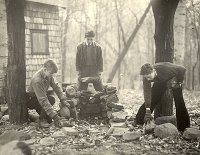 In 1951 the school began to
In 1951 the school began to
dismantle Evamere Farm, and by 1955 had begun selling off large parcels of the farm and the extensive woods that adjoined it. A significant portion of the farm property is now home to community schools and private residences.
In the early 1970s, the Hudson Park Board also acquired a section of this area. Later, during the American Bicentennial of 1976, the area encompassing the stone dam and Senior Cabin ruins was purchased and presented to the Park Board.
With the recent election of Mark R. Tercek '75 as president of the WRA Board of Trustees, we now have the ninth person to serve in this capacity since WRA was reorganized in 1916. It should be noted that among the previous eight board presidents, Robert S. Wilson holds the record for service which likely will not soon be surpassed. He was named president in 1941 following the sudden death of Warren M. Bicknell and served until his retirement in 1967.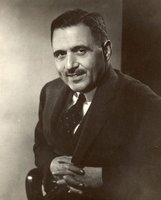 Robert S. Wilson, son of a Presbyterian minister, went to Shadyside Academy and was a graduate of Princeton, class of 1910, where he was a member of both the wrestling and swimming teams. He had a long career with Goodyear in Akron, retiring as a vice president. But it is interesting to learn that he himself had a background in teaching, having taught Latin for two years at Lawrenceville before entering the field of business.
Robert S. Wilson, son of a Presbyterian minister, went to Shadyside Academy and was a graduate of Princeton, class of 1910, where he was a member of both the wrestling and swimming teams. He had a long career with Goodyear in Akron, retiring as a vice president. But it is interesting to learn that he himself had a background in teaching, having taught Latin for two years at Lawrenceville before entering the field of business.
Mr. Wilson was elected to the WRA Board of Trustees in 1936, so he already had ten years of service by the time Dr. Hayden retired in 1946 and the search for a new headmaster began. It was at this point that fellow trustee Robert C. Brouse '31 proposed that Wilson himself be considered for the job. He declined the nomination, but was very much a part of the committee that brought John W. Hallowell to the school as headmaster. Together, Hallowell and Wilson worked for the well-being of WRA for the next 21 years. In 1963 the school dedicated Wilson Hall, the home of both the science department and the library, and named it in honor of the longtime board president. When the headmaster retired in 1967, Mr. Wilson also retired as board president and was succeeded by Robert C. Brouse. He passed away in 1970 at the age of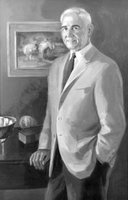 80.
80.
Robert S. Wilson's two sons, John '35 and David '38, were both WRA graduates, and David served on the Board of Trustees from 1958 to 1981, much of the time as board secretary. He now lives in Portland, Oregon, with his son, David, Jr.'63. Another son is Robert S. Wilson II '65. Many alumni are familiar with the portrait of Robert S. Wilson (on right) that graces Wilson Hall, but we are also posting a photo of him (above) taken about the time he became board president in 1941.
Upon his passing away in 1970, Wilson was eulogized by former Headmaster John W. Hallowell who wrote, "...all who knew him were infected with the joy and goodness he found in life. And joy was there because of his simple faith, his never-failing hope, his selfless love... " One can read more about Robert S. Wilson in Robert F. Pryce's book, The Hallowell Years (1980).
 hilly location on the north end of the WRA campus. For many years this house, built in the early 1960s, stood at 301 Aurora Street with its back to our property. When the new owner proposed that the house be demolished in order to make way for a larger one, WRA was contacted about accepting the residence as a gift. The house has now been successfully moved to its new position on our campus, and by next summer, should be ready for a faculty family.
hilly location on the north end of the WRA campus. For many years this house, built in the early 1960s, stood at 301 Aurora Street with its back to our property. When the new owner proposed that the house be demolished in order to make way for a larger one, WRA was contacted about accepting the residence as a gift. The house has now been successfully moved to its new position on our campus, and by next summer, should be ready for a faculty family. present Congregational Church since 1847. On Saturday, May 13, 2000, the structure began to make its way a quarter mile to a new location just behind the Knight Fine Arts Center on Oviatt Street. The move took all day. Once settled on a vacant Reserve lot, the structure underwent extensive restoration and received a kitchen and den addition to the rear of the house. It is now in use as a faculty residence.
present Congregational Church since 1847. On Saturday, May 13, 2000, the structure began to make its way a quarter mile to a new location just behind the Knight Fine Arts Center on Oviatt Street. The move took all day. Once settled on a vacant Reserve lot, the structure underwent extensive restoration and received a kitchen and den addition to the rear of the house. It is now in use as a faculty residence.









